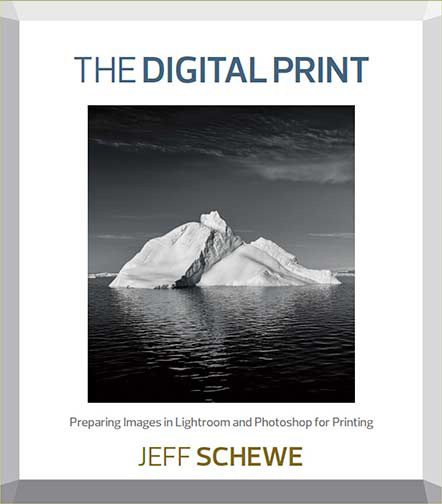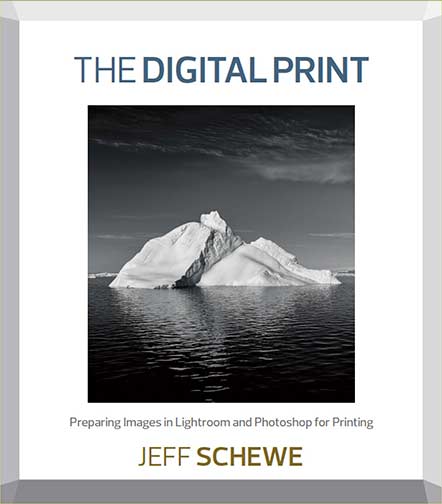


Many people, regardless of the quality of their gear, are happy taking a good photograph and sharing it online. Or maybe having a lab make the occasional print. But for 150 years theraison d’êtreof photography has been the fine print. Some people, regardless of how sophisticated their equipment, are satisfied placing their images on-line, or maybe having a lab make an occasional print.
Since the beginning of photography some 150 years ago the photographic print has been the end goal of the photographic process. When making a fine print one is creating a physical manifestation of what was in one’s mind’s eye when the image was created. It is the finalobjet d’art.
Some regard the process of print making as simple – attach the printer, read the relevant manuals, and press the PRINT bottom. If only it were so. That’s like saying that sitting down at a piano and pressing the keys makes music. It it fair to say, that just as many musicians hear the piece of music in their minds before they sit down to play, many photographer visualize what the final print will look like when they are taking the shot. What the framing will be, the cropping, the tonalities and all the other adjustments and manipulations of the tools and processes that will be needed to produce the final print that says when wants to be said.
So – how does one learn how to become a fine printer in the digital era? Strangely, there aren’t many books on the subject, and those few that exist have been outdated quickly as the technology moves forward at its inexorable pace. One solution, and maybe the best yet, is a new book by Jeff Schewe titled The Digital Print, first published in August, 2013.

Example of the many detailed illustrations in The Digital Print
About Jeff Schewe
There are a few things that you need to know about Jeff, other than that he’s quite a large individual, has a full beard, rides a Harley, and doesn’t suffer fools gladly. The first is that Jeff is the real deal when it comes to his knowledge of Adobe’s image processing products, from Photoshop to Lightroom. He’s been involved with Adobe as a consultant, alpha tester, beta tester, and even has some software code developed by his company Pixel Genius, as part of the sharpening routines in these programs. Jeff also knows many of the programmers and program managers at Adobe on a personal basis. Finally, Jeff has been involved with Photoshop, Camera Raw and Lightroom from the earliest days and has an eidetic memory when it comes to what feature appeared where and when. Scary sometimes.
In other words, if Jeff says something about how these programs work, you can take it to the bank. He’s rarely wrong.
Jeff is also an ex-commercial photographer and now an avid amateur and educator. He has been elected as a member of the NAPP Photoshop Hall of Fame.
In other words, he doesn’t just talk the talk, he most definitely walks the walk.
The Digital Print – Preparing Images in Lightroom and Photoshop for Printing
Printing is, obviously, not just about pressing the button on-screen that says PRINT. Printing also includes a myriad of choices, including which printer and ink set to purchase, what papers to use, and how to set everything up properly so that what you see on your screen and what end up on paper are as close as possible.
But the key phrase here is “what you see on your screen“. One doesn’t simply take what the camera recorded verbatim, but rather the photographer / printer enter into a dialog with the image. What do you want the final print to look like? What does it contain that you don’t want to be there in the end? What colours or tonalities do you want the print to have that best express what the image is about? And most important of all – what are the steps needed to actualize your vision for the final print? And then finally, how the hell do I do what’s needed?
That’s what Jeff’s The Digital Print is designed to do – teach and guide you though the steps of what to do and how to do it.
It’s an Adobe World
The programs that are discussed and taught in this book are Adobe’s Lightroom and Photoshop / Camera Raw. There are of course other fine programs for image processing and printing, but these are the ones that Jeff has chosen to concentrate on and these are the ones that he knows best. Of course these are also the programs that have the largest market-share.
But The Digital Print covers more than just using these programs to prepare images for printing. There are in depth discussions of colour management, system profiling and all of the steps along the way from taking the original file, be it JPG or raw, through rendering the final image on your preferred paper both in colour and in B&W. Print presentation materials and strategies are also covered.
In short, this is about as comprehensive a book as one could want about the science, art and technique of photographic printing, using the mainstream hardware and software tools that are available in 2013.
Jeff and I have done a video tutorial series titled From Camera to Print and Screen which explores many of these topics from a different perspective and using differing tools and materials. For those that learn best and find a book to be the preferred learning tool I can heartily recommend Jeff’s new book. It is the new how-to bible for printers and should be on every photographers book shelf and on every printers work table.
Jeff Schewe Interview
After the filming of the Lightroom 5 tutorial in Chicago, Kevin Raber sat down with Jeff and enjoyed a glass of wine together as they discussed Jeff’s photographic history, his involvement with Adobe and how he began a career of writing his best selling books.
Kevin Raber interviews Jeff in May, 2013
Disclaimers
1: The author of this book, Jeff Schewe, is both a personal friend and a business colleague. We’ve know each other for about 10 years, and have done quite a few video training tutorials on raw processing, Camera Raw, Lightroom, and Printing, all of which are found on this site’s store pages.
2: Jeff is a lot bigger than I am, and if I don’t give this book a good review there’s the possibiliy of bodily harm.
3: But, I don’t give a crap how big he is or how long I’ve known him, as regular readers know, I call ’em as I see ’em.
Michael Reichmann
July, 2013
Updated: March 25, 2015

Lorem ipsum dolor sit amet, consectetur adipiscing elit, sed do eiusmod tempor incididunt ut labore et dolore magna aliqua. Ut enim ad minim veniam, quis nostrud exercitation ullamco laboris nisi ut aliquip ex ea commodo consequat. Duis aute irure dolor in reprehenderit in voluptate velit esse cillum dolore eu fugiat nulla pariatur. Excepteur sint occaecat cupidatat non proident, sunt in culpa qui officia deserunt mollit anim id est laborum.
Lorem ipsum dolor sit amet, consectetur adipiscing elit, sed do eiusmod tempor incididunt ut labore et dolore magna aliqua. Ut enim ad minim veniam, quis nostrud exercitation ullamco laboris nisi ut aliquip ex ea commodo consequat. Duis aute irure dolor in reprehenderit in voluptate velit esse cillum dolore eu fugiat nulla pariatur. Excepteur sint occaecat cupidatat non proident, sunt in culpa qui officia deserunt mollit anim id est laborum.
You May Also Enjoy...
Photokina
September 25, 2006 © 2006 The Luminous Landscape Inc.All Rights ReservedSubscribe to The Video Journal Return to the Photokina Videoblog Index Page
Red Leasf – Yellow Stripe
Please use your browser'sBACKbutton to return to the page that brought you here.
